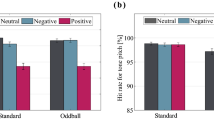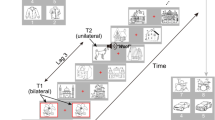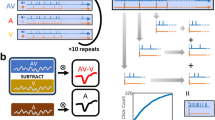Abstract
The auditory sensory gating system modulates its sensitivity to incoming stimuli and prevents higher brain functions from sensory overload in the primary auditory cortex. We investigated whether visually evoked emotional stimuli affect auditory sensory gating. Magnetic P50 (P50m) suppression was evaluated by magnetoencephalography in fifteen healthy subjects while they viewed slides varying in emotional valence and arousal. The ratio of strength of dipole moments of the 2nd to the 1st P50m and the anatomical location of their sources were calculated. Negatively valenced slides significantly attenuated P50m suppression, as compared to neutral ones, while the effects of positive slides were insignificant. No effects on latencies or the location of P50m sources were observed. Thus, negative emotional stimuli may modulate sensory gating.
Similar content being viewed by others
References
Adler LE, Hoffer LJ, Griffith J, Waldo MC, Freedman R (1992) Normalization by nicotine of deficient auditory sensory gating in the relatives of schizophrenics. Biol Psychiatry 32:607–616
Adler LE, Olincy A, Cawthra E, Hoffer M, Nagamoto HT, Amass L, Freedman R (2001) Reversal of diminished inhibitory sensory gating in cocaine addicts by a nicotinic cholinergic mechanism. Neuropsychopharmacology 24:671–679
Adler LE, Pachtman E, Franks RD, Pecevich M, Waldo MC, Freedman R (1982) Neurophysiological evidence for a defect in neuronal mechanisms involved in sensory gating in schizophrenia. Biol Psychiatry 17:639–654
Ahlfors S, Ilmoniemi RJ (1989) Magnetometer position indicator for multichannel MEG. In: Williamson SJ, Hoke M, Romani GL (eds) Advance in Biomagnetism, Plenum Press, New York, pp 673–676
Amaral DG,Price JL,Pitkänen A, Carmichael ST (1992) Anatomical organization of the primate amygdaloid complex. In: Aggleton JP (eds) The Amygdala: Neurological Aspects of Emotion, Memory, and Mental Dysfunction, Wiley-Liss, New York, pp 1–66
Bordi F, LeDoux J (1992) Sensory tuning beyond the sensory system: an initial analysis of auditory response properties of neurons in the lateral amygdaloid nucleus and overlying areas of the striatum. J Neurosci 12:2493–2503
Braff DL, Geyer MA (1990) Sensorimotor gating and schizophrenia. Human and animal model studies. Arch Gen Psychiatry 47:181–188
Cuthbert BN, Schupp HT, Bradley MM, Birbaumer N, Lang PJ (2000) Brain potentials in affective picture processing: covariation with autonomic arousal and affective report. Biol Psychol 52:95–111
Hämäläinen M, Hari R, Ilmoniemi RJ, Knuutila J, Lounasmaa OV (1993) Magnetoencephalography – theory, instrumentation, application to noninvasive studies of working brain. Rev Mod Phys 65:413–498
Hari R, Aittoniemi K, Jarvinen ML, Katila T, Varpula T (1980) Auditory evoked transient and sustained magnetic fields of the human brain. Localization of neural generators. Exp Brain Res 40:237–240
Kayser J, Tenke C, Nordby H, Hammerborg D, Hugdahl K, Erdmann G (1997) Event-related potential (ERP) asymmetries to emotional stimuli in a visual half-field paradigm. Psychophysiology 34:414–426
Lang PJ, Bradley MM, Cuthbert BN (1997) International Affective Picture System (IAPS). NIMH Center for the Study of Emotion and Attention
Lang SF, Nelson CA, Collins PF (1990) Event-related potentials to emotional and neutral stimuli. J Clin Exp Neuropsychol 12:946–958
Laurian S, Bader M, Lanares J, Oros L (1991) Topography of event-related potentials elicited by visual emotional stimuli. Int J Psychophysiol 10:231–238
LeDoux JE (1993) Emotional memory systems in the brain. Behav Brain Res 58:69–79
Light GA, Malaspina D, Geyer MA, Luber BM, Coleman EA, Sackeim HA, Braff DL (1999) Amphetamine disrupts P50 suppression in normal subjects. Biol Psychiatry 46:990–996
Mäkelä JP, Hämäläinen M, Hari R, McEvoy L (1994) Whole-head mapping of middle-latency auditory evoked magnetic fields. Electroencephalogr Clin Neurophysiol 92:414–421
McGhie A, Chapman J (1961) Disorders of attention and perception in early schizophrenia. Br J Med Psychol 34:103–116
Morris JS, Frith CD, Perrett DI, Rowland D, Young AW, Calder AJ, Dolan RJ (1996) A differential neural response in the human amygdala to fearful and happy facial expressions. Nature 383:812–815
Patrick G, Straumanis JJ, Struve FA, Fitz-Gerald MJ, Leavitt J, Manno JE (1999) Reduced P50 auditory gating response in psychiatrically normal chronic marihuana users: a pilot study. Biol Psychiatry 45:1307–1312
Reite M, Teale P, Zimmerman J, Davis K, Whalen J (1988) Source location of a 50 msec latency auditory evoked field component. Electroencephalogr Clin Neurophysiol 70:490–498
Rogan MT, Staubli UV, LeDoux JE (1997) Fear conditioning induces associative long-term potentiation in the amygdala. Nature 390:604–607
Schupp HT, Cuthbert BN, Bradley MM, Birbaumer N, Lang PJ (1997) Probe P3 and blinks: two measures of affective startle modulation. Psychophysiology 34:1–6
Surakka V, Tenhunen-Eskelinen M, Hietanen JK, Sams M (1998) Modulation of human auditory information processing by emotional visual stimuli. Brain Res Cogn Brain Res 7:159–163
Author information
Authors and Affiliations
Corresponding author
Rights and permissions
About this article
Cite this article
Yamashita, H., Okamoto, Y., Morinobu, S. et al. Visual emotional stimuli modulation of auditory sensory gating studied by magnetic P50 suppression. Eur Arch Psychiatry Clin Neurosci 255, 99–103 (2005). https://doi.org/10.1007/s00406-004-0538-6
Received:
Accepted:
Published:
Issue Date:
DOI: https://doi.org/10.1007/s00406-004-0538-6




